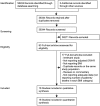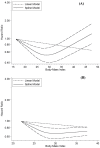Body Mass Index-Related Mortality in Patients with Type 2 Diabetes and Heterogeneity in Obesity Paradox Studies: A Dose-Response Meta-Analysis
- PMID: 28046128
- PMCID: PMC5207428
- DOI: 10.1371/journal.pone.0168247
Body Mass Index-Related Mortality in Patients with Type 2 Diabetes and Heterogeneity in Obesity Paradox Studies: A Dose-Response Meta-Analysis
Abstract
Objective: We conducted a systematic review and meta-analysis of studies to quantify the association between body mass index (BMI) and the risks of all-cause and cardiovascular mortality in patients with type 2 diabetes.
Methods: We included studies assessing the impact of BMI on all-cause and cardiovascular mortality in patients with type 2 diabetes. Data were combined using a random-effects dose-response model.
Results: Sixteen cohort studies on all-cause mortality (n = 445,125) and two studies on cardiovascular mortality (n = 92,841) were evaluated in the meta-analysis. A non-linear association was observed between BMI and all-cause mortality among patients with type 2 diabetes. With a BMI nadir of 28-30 kg/m2, the risk of all-cause mortality displayed a U-shaped increase. With a BMI nadir of 29-31 kg/m2, the risk of cardiovascular mortality exhibited a gradual non-linear increase for BMI > 31 kg/m2. Subgroup analyses suggested that study location, diabetes duration, and smoking history may have contributed to heterogeneity among the studies.
Conclusions: An obesity paradox exists for patients with type 2 diabetes with respect to all-cause and cardiovascular mortality. Study location, diabetes duration, and smoking history might contribute to heterogeneity among obesity paradox studies of patients with type 2 diabetes.
Conflict of interest statement
The authors have declared that no competing interests exist.
Figures



References
-
- Rodbard HW, Blonde L, Braithwaite SS, Brett EM, Cobin RH, Handelsman Y, et al. American Association of Clinical Endocrinologists medical guidelines for clinical practice for the management of diabetes mellitus. Endocr Pract. 2007; 13 Suppl 1: 1–68. - PubMed
-
- Gregg EW, Cadwell BL, Cheng YJ, Cowie CC, Williams DE, Geiss L, et al. Trends in the prevalence and ratio of diagnosed to undiagnosed diabetes according to obesity levels in the U.S. Diabetes Care. 2004; 27: 2806–2812. - PubMed
-
- Ruderman NB, Schneider SH, Berchtold P. The "metabolically-obese," normal-weight individual. Am J Clin Nutr. 1981; 34: 1617–1621. - PubMed
Publication types
MeSH terms
LinkOut - more resources
Full Text Sources
Other Literature Sources
Medical

